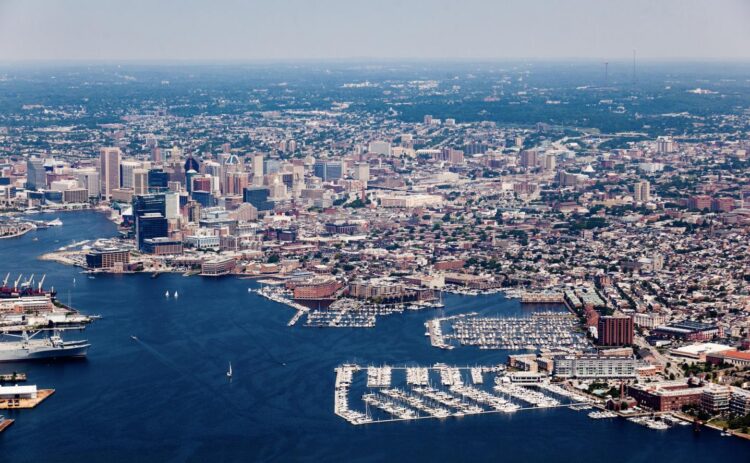Synthesis of five frameworks seeks to advance global urban science

Credit: Will Parson/Chesapeake Bay Program
Urban areas are on the rise and changing rapidly in form and function, with spillover effects on virtually all areas of the Earth. The UN estimates that by 2050, 68% of the world’s population will reside in urban areas. In the inaugural issue of npj Urban Sustainability, a new Nature Partner Journal out today, a team of leading urban ecologists outlines a practical checklist to guide interventions, strategies, and research that better position urban systems to meet urgent sustainability goals.
Co-author Steward Pickett of Cary Institute of Ecosystem Studies explains, “Urban areas shape demographics, socio-economic processes, urban form, technologies, and the environment – both near and far. As the world becomes more urbanized, what we do in cities will be key to achieving global sustainability goals.There is great potential, but achieving it will require integrating knowledge, methods, and expertise from different disciplines to advance global urban science that catalyzes discovery and innovation.”
Pickett collaborated with Timon McPhearson, a Research Fellow at Cary Institute and Professor at The New School in New York City, and lead author Weiqi Zhou of the Research Center for Eco-Environmental Sciences of the Chinese Academy of Sciences in Beijing, on the paper, which is the first to bring together five leading frameworks of urban ecology. Their synthesis refines our capacity to understand urban systems, ranging from cities to urban regions, by facilitating the interdisciplinary science needed to achieve sustainability and improve human and environmental wellbeing.
The paper’s authors are international leaders in advancing the key frameworks of urban ecology explored in the paper, among them: the human ecosystem, disturbance and extreme events in urban systems, resilience in cities and urban communities, dynamic heterogeneity, and the new ‘continuum of urbanity’ that describes interactions and flows in urban-rural-wild regions. Although these and other frameworks have been instrumental in guiding the development of urban ecology, their synthesis addresses a need for greater conceptual comprehensiveness and unification.
Pickett explains, “Urban ecological science is a young discipline. Because of its youth, many different methods have been proposed to unify the discipline so that it can progress more rapidly and be more accessible to urban designers, policy makers, architects, and engineers. But these various conceptual tools, theories, and approaches are seemingly quite disparate, and rarely has the overlap among them been evaluated to promote a more complete, and therefore more useful, synthesis.”
Overarching global urban conditions provide the content for the frameworks: complexity, diffuseness, connectivity, and diversity. Frameworks were explored using a ‘metacity’ concept that conceives of urban areas, at any scale, as consisting of patches differentiated by interacting biophysical, social, and technological components. Four case studies were detailed: extreme urban heat, the role of vacant land in urban areas, green stormwater infrastructure, and new urban development in China. For the latter two, the authors provide practical examples of how the frameworks can serve as a checklist for assessing sustainability planning.
McPhearson comments, “By offering a strong interdisciplinary lens on urban systems, the integrated frameworks can counter the risk that problems prioritized by special interests may be over-simplified, that opportunistically identified themes may be pursued to the detriment of strategic choices, or that strictly technological response to an immediate crisis may substitute for more inclusive and systemic rosters of choices.”
The paper builds on more than 25 years of Cary Institute leadership in human-natural systems research. Pickett, a pioneer of American urban ecology, notes that “The long-term Baltimore Ecosystem Study has uniquely prepared this group to make the synthetic contribution represented by this paper. Cary Institute’s emphasis on collaboration and synthesis, and the intellectual freedom it affords to pursue radical new directions in ecology, including deeply interdisciplinary ones, are important catalysts for the work underpinning this paper.”
###
Access the full paper, Conceptual Frameworks Facilitate Integration for Transdisciplinary Urban Science, https:/
Cary Institute of Ecosystem Studies is an independent nonprofit center for environmental research. Since 1983, our scientists have been investigating the complex interactions that govern the natural world and the impacts of climate change on these systems. Our findings lead to more effective management and policy actions and increased environmental literacy. Staff are global experts in the ecology of: cities, disease, forests, and freshwater.
Media Contact
Lori M Quillen
[email protected]
Related Journal Article
http://dx.





